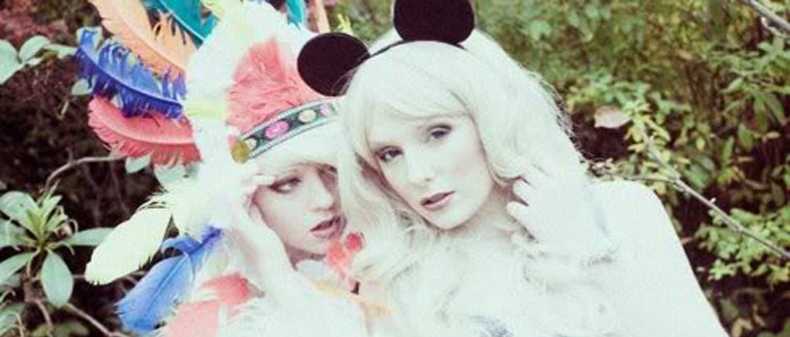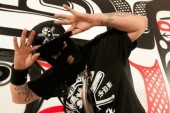
image courtesy of unsettlingamerica.wordpress.com
Navajo prints, tribal-inspired beading, feathered hair extensions. These are a few of the aboriginal “inspired” trends that flooded the fashion scene this year. From high (designer labels like Proenza Schouler and Rodarte) to low (retail chains like Zara and Urban Outfitters), dabbling in the art of a mass cultural rip-off was rife in the fashion business.
Headdresses are a spiritual sign of respect and courage in the aboriginal community? Let’s slap it on a 97-pound model as a grand finale. Eagle feathers are a symbol of the sacred bird? Let’s make them into earrings instead, dah-ling.
Being aboriginal, even though I may not look it — I inherited my dad’s French-Italian (white) skin colour — I’ve grown more and more frustrated with fashion’s recent fetish with ripping off my aboriginal culture.
Head-to-toe, bag-to-shoe, I saw my culture pop up everywhere this year, from the glossy store windows of Louis Vuitton to the sales racks at your local mall. I saw high-top moccasins, fringed tops, Navajo prints, beaded headbands, and feathered accessories of all kinds– all of which, although ‘inspired,’ do not true fashion inspiration make. True fashion inspiration takes cue, not copy, and creates something new. This is instead a cultural pigeonhole– a hackneyed attempt at searching for new fashions while creating an ugly, cheap copy in the process.
Proenza Schouler’s ‘Native American-themed’ ad
“There’s one thing about taking inspiration and there’s another thing about appropriating, or even just flat out copying. One should not be mixed with the other,” says Lisa Charleyboy, an aboriginal freelance writer and fashion blogger. “There tends to be an exotification of other cultures that exists [in fashion], whether it be aboriginal or African.”
Take the Rodarte fall 2012 collection for instance. Megan Davis, aboriginal law professor and expert member of the United Nations Permanent Forum on Indigenous Issues, took the lead for aboriginal communities that were outraged over its simplistic and hypocritical approach towards native culture. At first I thought the collection was beautiful and Davis was cuing violins, but I now see her point: the line used prints linked to aboriginal spirituality (which centers around being one with the earth), yet used less-than-eco-friendly materials.
Rodarte fall 2012 photo courtesy of kls.com
Like the fashion industry, many people tend to see ‘aboriginal’ as a narrow number of things. It’s human nature to categorize entities and put them in the box–especially entities they don’t understand. People are scared to ask questions about an unknown culture and rarely make any effort to fully understand it. Instead they’ll err towards blatant stereotypes: insert pleather moccasin joke here.
“I think there’s a respect issue,” says Tara Barnes, head of communications for authentic aboriginal brand Manitobah Mukluks. “Recognizing the past and the history of where that product came from, and respecting its intent and origin, is really important.”
I’ll be the first to admit that the aboriginal culture isn’t an easy one to grasp. It’s understandable why most people don’t know something is offensive. In fact, it took me almost 20 years to figure it out myself!
So why aren’t people, especially fashion folk, more educated about native culture?
“It’s a shame that people just learn about aboriginal culture in history class as though it’s some dead culture instead of a thriving one,” says Barnes. “They don’t understand the modern issues or challenges of the aboriginal community. They don’t see a call to supporting authentic products, let alone supporting the community at large.”
The problem is this: manufacturing fashion products to directly resemble a cultural group’s creative doing, without hiring said cultural group to make them or even taking a unique “spin” on it, is pretty much the equivalent to making a movie inspired by someone’s life without getting their permission to do so. It’s copyright infringement. It’s taking Pocahontas and calling it Avatar.
Navajo-printed flasks are not a flattering homage (it takes one look at the high rates of alcohol and substance abuse among Aboriginal people to figure out why)– yet they’re socially accepted as a fashion statement because they’re ‘pretty’ and ‘new’ to the average consumer.
The problem lies not only in what these designers are doing, but how they are doing it. If you’re making moccasins, why not hire aboriginal people to actually make them? Not only will your products turn out with a higher quality finish, but the financial support for the aboriginal community would be much appreciated as well.
image courtesy of Manitobah MukluksCompanies like Manitobah Mukluks, however un-high fashion they may be, at least contract real aboriginals to make some of their products. Their factories are located within in our own country and they know the background of the products they make. So instead of making moccasins out of a horrible pleather material (looking to you H&M), how about going to Attawapiskat and seeing if any locals have deerskin to sell you for these ‘authentic’ products? How about paying aboriginal workers to make a limited-edition collection of said items, instead of a mass collection of meh sloppily pieced together by man-made machines?
*Side note: if you are indeed going to outsource work to aboriginals, don’t try and take advantage of my people’s labour rights or living conditions-— the government’s already got that covered aplenty.
Sadly, though, the fashion industry doesn’t much care whether they’re guilty of cultural appropriation. And they don’t care why I care. Although the Attawapiskat housing crisis is an extreme example of my culture’s current living conditions, most reserves aren’t too far off-— and that’s why I care. People may not want to know this, but communities are literally living in third-world conditions within our own country. Some support, employment, and recognition would go a long way in these communities.
Something fashion just flat out refuses to do.
In a sense, fashion has actually done the opposite of that. It’s created competition for local aboriginal retailers and forced them to, essentially, ‘immigrate’ towards other income opportunities. Why buy the real thing from an entrepreneurial artisan when you can now get them down the street for 30 bucks cheaper at Aldo? They won’t last as long… but they’re cheaper!
To fashion’s credit, it never did (and never will) claim to be a forgiving business. It has claimed to be an adaptive one, though. In the words of writer Quentin Crisp, “Fashion is what you adopt when you don’t know who you are.” I suggest fashion figures out who the aboriginal people are — and quick – before they do more irreparable damage than they already have.
slider image courtesy of mycultureisnotatrend.tumblr.com________
Christian Allaire writes about style for Toronto Standard. Follow his tweets here: @chrisjallaire.
For more, follow us on Twitter @TorontoStandard and subscribe to our newsletter.














